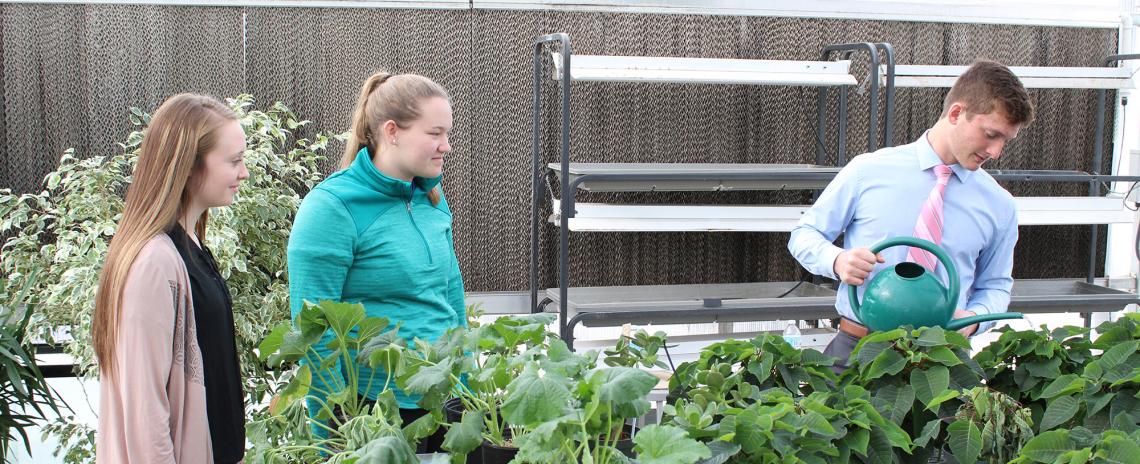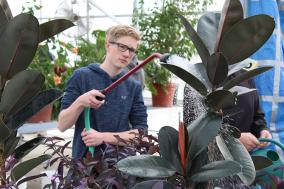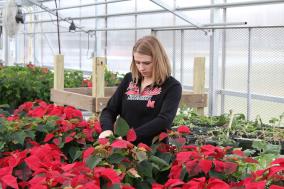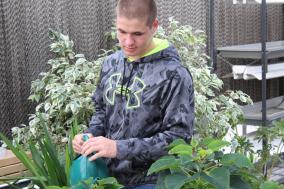Greenhouse enriches learning experience for agriculture students at Blair High School
Greenhouse enriches learning experience for agriculture students at Blair High School
By Tyler Dahlgren
NCSA Communications Specialist
At Blair High School, a 20-minute highway cruise north of Omaha, agriculture students have a unique on-campus tool at their disposal in the form of a full-size greenhouse that, since last year, also houses an aquarium.
Fourth-year teacher Jill Hensley, who graduated from the University of Nebraska at Lincoln with a degree in Agricultural Education and minors in Agricultural Economics and Coaching, feels the facility, which opened in the fall of 2007, sparks enthusiasm amongst a large contingent of students interested in agriculture.
“It’s usually one of the first questions they ask at the start of the semester if they’ve never taken a class with me,” Hensley said. “They want to know ‘When are we going to go to the greenhouse?’”
Hensley said her students view visits to the greenhouse, which is located on the northern edge of campus in plain sight for those entering BHS’s main parking lot, as a privilege. The chance to see tangible proof of their work throughout the semester is intriguing and attracts curious students during registration.
“Students respond night and day different when they get the chance to do something like that, and you instantly have a hook with those greenhouse classes,” Hensley said. “Even in the classes that aren’t out there the majority of the time, you still have a hook and the students are instantly interested and want to be involved.”
It’s common to see agriculture teachers double as shop teachers, and while Hensley is certified to do so, running a table saw isn’t her cup of tea, so the Burwell native took some extra classes after graduating college, including a horticulture lab at UNL, to better equip herself to manage a greenhouse.
The extra instruction led to an enhanced confidence, and four years later Hensley said the greenhouse is in just as good of shape if she’s gone for a week than if she’s there, a testament to the care provided by students.
“It’s fun to have a lab, and fun to have a place where you can go and reinforce classroom concepts, especially in an industry like agriculture, which leads the nation in careers,” Hensley said. “To show students what a career can actually look like and have them live it out, it’s fun.”
Students echo that sentiment.
“Just to be able to get out of the classroom for a bit and do some hands-on activities, that is really beneficial to us,” said senior Cody Lambrecht, in between watering plants decked out in suit and tie prior to that night’s Jamboree basketball game.
At first, upkeep was borderline overwhelming for Hensley, who said she felt all the weight of running the greenhouse on her shoulders. That has changed.
“Every day, students are out there watering plants, transplanting them, sweeping the floors, and if it’s a cleaning day they wash the floors down,” Hensley said. “On weekends, there are some responsible students that have access to the greenhouse and they get to count those hours as a part of their “Supervised Ag Program”, so even on the weekends it’s in the hands of the students.”
There are two classes, Plant and Soil Science and Horticulture, that spend a majority of their classroom time in the greenhouse, experiencing everything from anatomy on up to reproductive stages through growing season. Since the greenhouse is a controlled environment, meaning students have control of humidity, temperature and sunlight, Hensley and her students are able to do experimental things that would be impossible in a solar setting or a classroom.
“A lot of schools in the state have what I would call educational greenhouses,” Hensley, who was enticed by the greenhouse when searching for teaching jobs after college, said. “Blair’s is not only educational, but I would say it mirrors a commercial greenhouse. Students are seeing the bigger scope of managing a greenhouse and the bigger scope of taking care of not only the plants, but the entire facility.”
The greenhouse, which was made possible through a surprise $60,000 donation from NatureWorks in Blair about a decade ago, has been useful for the community and other classes at BHS as well. Students care for and propagate community members’ plants, and Hensley is always willing to allow a science class to use the greenhouse for in-class activities.
“Not only do we get to do a lot of hands-on stuff and learn while actually taking care of real plants, but we are going to get to give them to a lot of different businesses in our community,” said junior Josie Barker.
The plant cuttings come from Stuart’s Flowers and Produce in Central City, and though that’s a few hours away, Hensley said the customer service and the company’s willingness to work hand-in-hand with schools has been phenomenal. In the spring, the seeds for vegetables and flowers comes from the Blair Garden Center.
As for the fish? They come from the Calamus Fish Hatchery near Hensley’s hometown of Burwell, where the manager is a close family friend and a phone call away if any technical issues were to arise.
“They love the fish,” Hensley said of her Fish and Animal Science and Agri-Science students. “The one hard part for students is that this year we put blue dye called “Algae Shade” in the water, so they can’t see the fish unless we catch them with a net. Periodically we will catch the fish and weigh them, but fish are like any species of livestock raised for food and they can get stressed, so we try to keep that at a minimum while still allowing the students to interact as much as they can.”
In the spring, students hold a three-day plant sale that not only provides real-world motivation to grow quality products, but business experience too.
Those three days are just another advantageous perk of a facility that enriches the learning experience of its students all year long.





